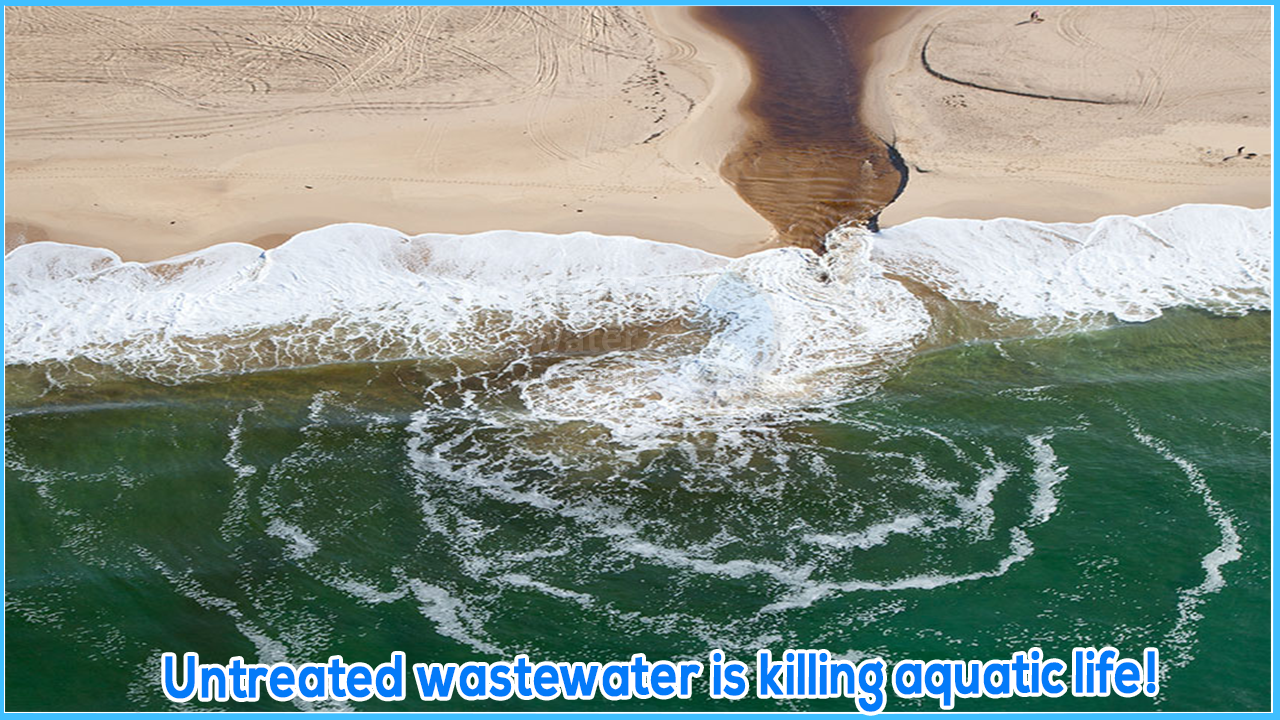Wastewater and sewage enter aquatic systems from sources ranging from surface runoff and septic systems to wastewater treatment facilities and storm drain outfalls. Every year, many people around the world become ill as a result of contaminated water during recreational activities such as swimming and boating. Many people don't associate their disease with the water they drank. However, the effects of water pollution on aquatic ecosystems go far beyond human illness.
DISPOSAL OF SEWAGE AND WASTEWATER
There are three stages of wastewater treatment-
- ~ The wastewater is placed in holding ponds during the initial step of treatment, known as primary treatment. Low-density items like fats and oils float to the top, while solid trash falls at the bottom. After that, the materials can be removed.
- ~ The second phase, often known as secondary treatment, involves the removal of dissolved and suspended biological material. Aerobic bacteria are used in most secondary treatment systems to digest organic substances in wastewater.
- ~ The tertiary or third-phase treatment of wastewater that will be released into sensitive ecosystems cleans it even further. Depending on the residual pollutants, tertiary treatment can be done in a variety of ways. Particulate matter is removed via sand filtration. Polyphosphate accumulating organisms are bacteria that can remove phosphorus. To remove nitrogen, nitrifying bacteria can be utilized.
Domestic wastewater comprises a variety of contaminants, including biological risks and microplastic particles, as well as soaps and fats. Agricultural wastewater contains pathogens, salts, insecticides, and fertilizers, among other things. Domestic and industrial wastewater, as well as runoff from storm drains, are all included in urban wastewater. Storm drains carry pollutants from yards and parks, as well as from roadways and parking lots (soil, pet waste, pesticides, herbicides, and fertilizers) (oil, gasoline, dirt and trash).Compounds such as petrochemicals and other chemicals, acids, radioactive elements, and salts are all found in industrial effluent. According to recent discoveries, a range of pharmaceuticals contaminate wastewaters.
HAZARDS TO BIOLOGIC HEALTH IN AQUATIC ENVIRONMENTS
Bacteria, fungus, parasites, and viruses are among the biological risks present in wastewater. E. coli, typhoid fever, salmonella, cholera, and shigellosis are examples of bacteria and bacterial diseases. Aspergillus is a type of fungus. Cryptosporidium, giardia, and roundworms are examples of parasites. Hepatitis A viruses, for example, can be discovered in wastewater. More humans are affected by biological waste from farms, houses, parks, and beaches.
Freshwater bacteria and other species require oxygen to digest the sewage they are surrounded by. These microorganisms can create hypoxic (oxygen-depleted) dead zones while breaking down sewage. Fish and other native creatures require oxygen to exist in these dead zones. People throughout the world get sickened by shellfish infected with sewage-related germs. Human gut bacteria can infect coral and cause coral bleaching disease in marine environments. Coral dies when it loses its native bacteria and algae, resulting in zones where the entire coral ecosystem, from bacteria to fish populations, dies.
NUTRIENT HAZARDS IN AQUATIC ENVIRONMENTS
Eutrophication is caused by nutrient-rich materials such as fertilizers, notably nitrogen and phosphorus, and waste products in both fresh and marine habitats. Algal blooms caused by an excess of nutrients reduce light transmission in the water, affecting plants and plankton while lowering oxygen levels. Decomposer bacteria devour increasingly more dissolved oxygen as the algae dies.
INDUSTRIAL WASTES IN AQUATIC ENVIRONMENTS
Industrial wastes are frequently treated in the same wastewater treatment plants as home wastes. Industrial waste comprises a wide range of chemicals, as well as heavy metals such as lead, mercury, cadmium, and arsenic. Because sewage treatment systems do not remove all of these pollutants, they are dumped into rivers, lakes, and marine waterways. Furthermore, some garbage may be dumped or spilt directly into aquatic habitats without being treated. Sewage contamination has an impact on marine life at all levels of the food chain.Fish tissues accumulate heavy metals as they consume plankton, algae, and smaller prey that contain the metals. Biomagnification is the term for this process. When other creatures, including humans, eat these fish, the heavy metals can build up to the point where the consumer is poisoned. These heavy metals may also accumulate in hazardous levels in fish.
POLLUTION OF THE AIR AND AQUATIC ECOSYSTEMS
Aquatic ecosystems are also impacted by industrial soot and smoke. Sulfur dioxide, when coupled with water vapor, produces sulfuric acid, sometimes known as acid rain. Acid rain and runoff lower the pH of the water, making it difficult for fish to absorb oxygen, salts, and nutrition. Calcium absorption is also hampered by a low pH. Many fish have an improper calcium balance, which causes their eggs to develop improperly, becoming excessively brittle or fragile. Fish have weak spines and bones, while crayfish have weak exoskeletons due to calcium insufficiency. Acid rain also leaches aluminum from soils, preventing crustaceans and fish from reproducing.Furthermore, when pH drops below 6, insects like mayflies and stoneflies can't survive, impacting the food chain.
LITTER IN AQUATIC ECOSYSTEMS
Litter washed into storm drains and subsequently into waterways is included in urban sewage. 70 percent of this garbage is anticipated to wind up on the bottom, 15 percent on beaches, and 15 percent floating in the water. Plastics account for 70% of the trash, with metal and glass accounting for the majority of the remaining 30%. More than 1,200 aquatic species have been found to ingest trash, live in or on it, or become entangled in it, according to studies. Microplastics, microscopic fragments of bigger plastics, account for a considerable portion of the plastic. This litter affects a wide range of animals, including mammals, fish, crabs, and others.




